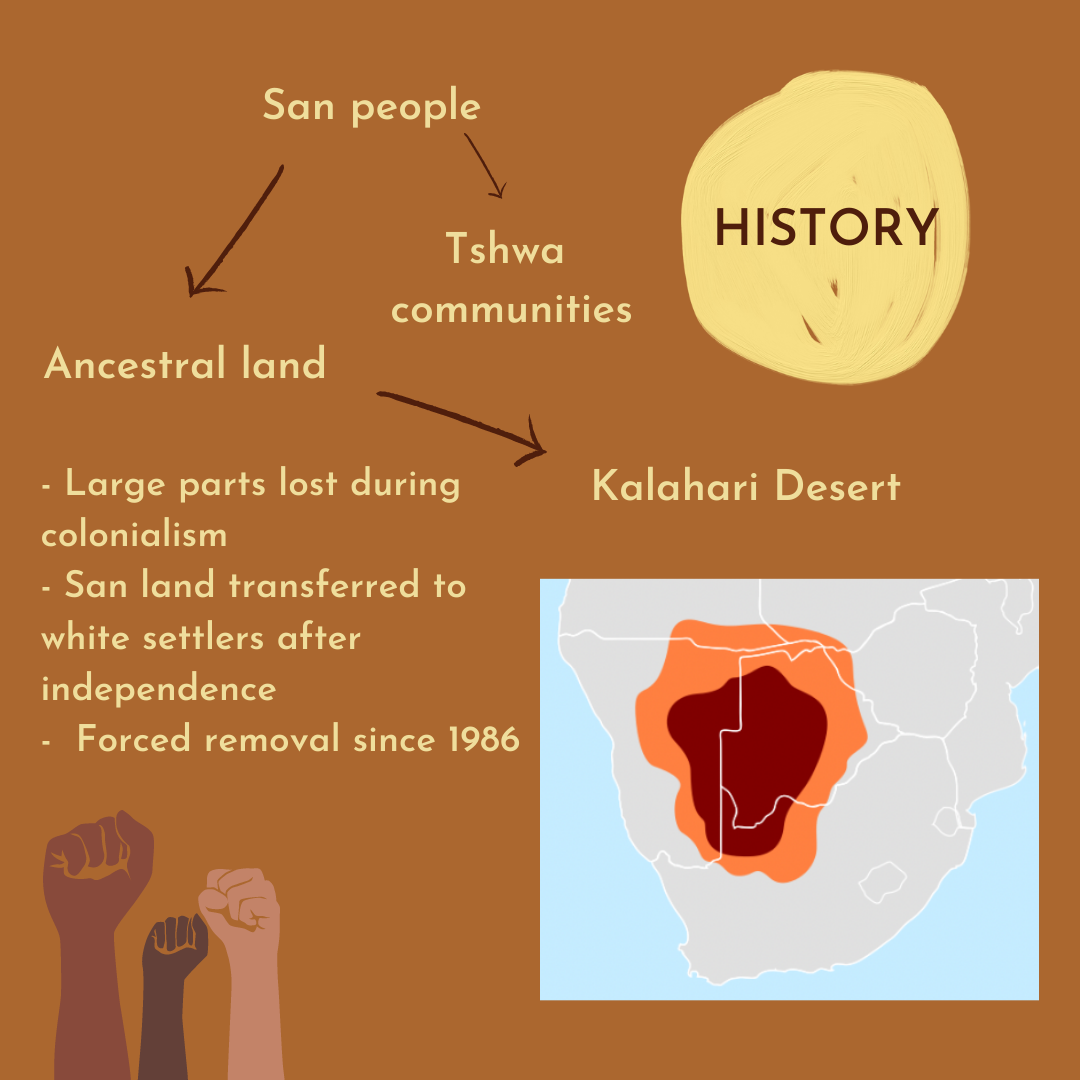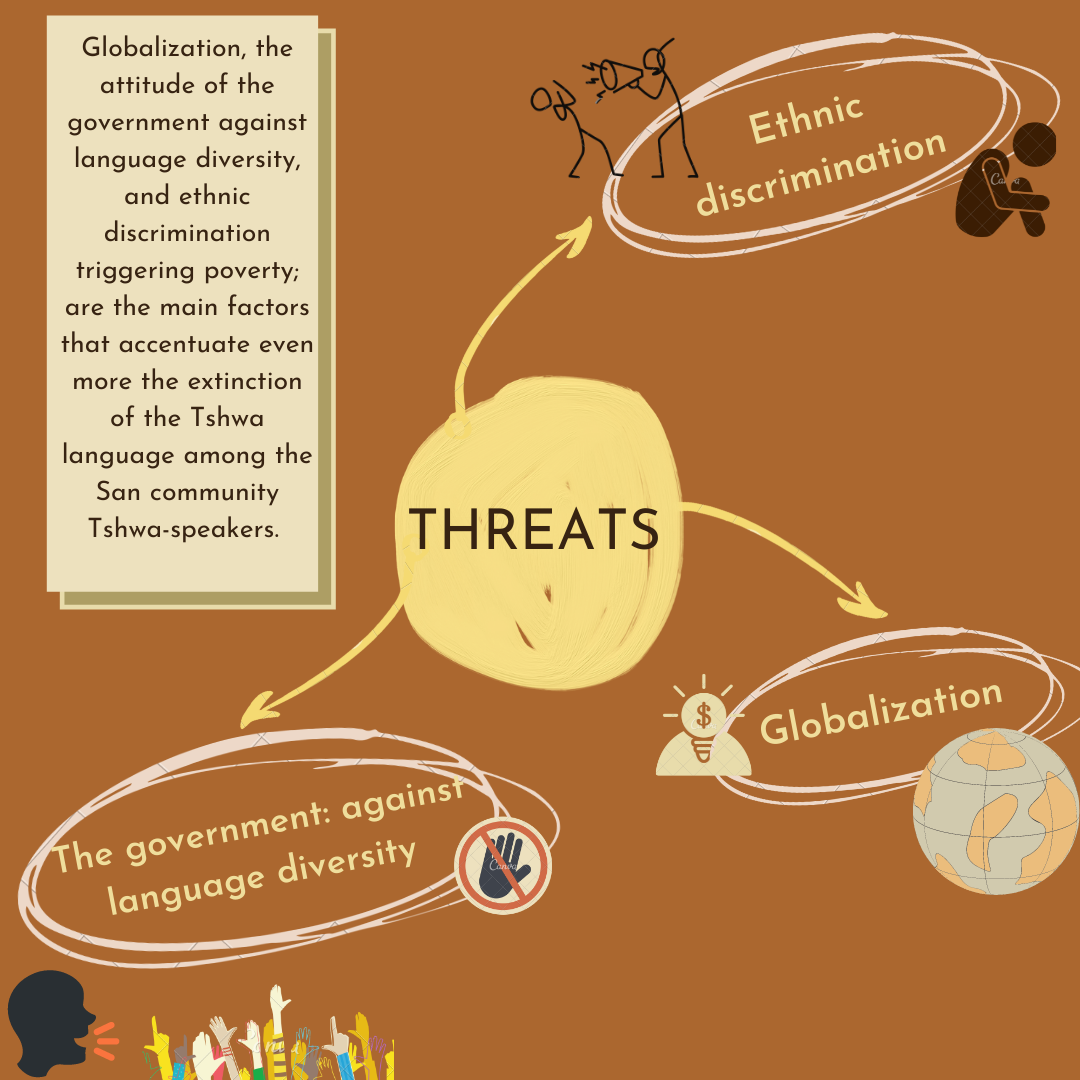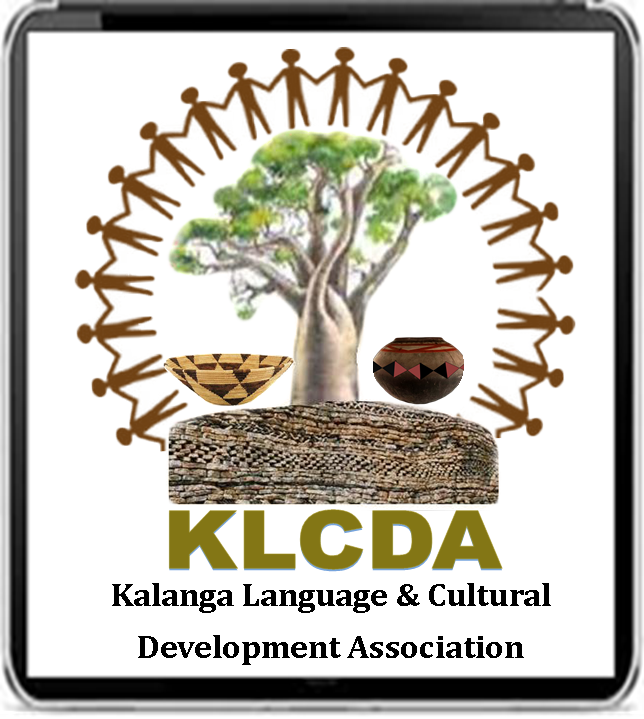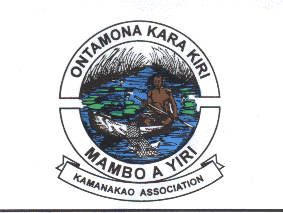GENERAL OVERVIEW
Tshwa language is a critically endangered language that is still present in Eastern Botswana (Chebanne and Nthapelelang, 2000; ELA). It belongs to the Khoe language family, which is the largest of the non-Ntu languages in Southern Africa (Du Plessis, 2019). However, this is not reflected in the number of speakers of Tshwa language. Exact numbers are contested, but estimates vary from 900 (ELA) to 3000 speakers (Lewis, 2009). The Tshwa language is no longer transmitted by the parent generation (Anaya, 2010; Chebanne and Nthapelelang, 2000), so its present day speakers are mainly old people who are socially isolated (Chebanne and Nthapelelang, 2000). Speakers of Eastern Khoe languages (including Tshwa) are increasingly adopting official national or regional languages such as Setswana and Ikalanga. Even in private sphere conversations the use of Tshwa language is decreasing, which poses a serious threat to the preservation of the language (Chebanne and Nthapelelang, 2000).


HISTORY
The San people, of which Tshwa communities are part, belong to earth’s oldest cultures. Traditionally, they lived around the Kalahari Desert, but large parts of their ancestral land have been lost during the colonial period (Anaya, 2010). This continued after the independence of Botswana in 1966, when San land was transferred to White settlers and majority agro-pastoral peoples. Since 1986, the San, including Tshwa communities, have been forcibly removed from their ancestral land in Central Kalahari (Hitchcock, 2002). Resettlement, stigmatisation, and poverty have resulted in a loss of natural, spiritual, and cultural resources, including Tshwa language (Ingstad and Fugelli, 2006).
1-Globalization: Kamwendo, Mooko and Moumaka (2009) in their research article stated that: ‘with English established as the official language, and Setswana as the national language, the exclusion of other indigenous languages continues.” This idea was reinforced by Batibo stating that “Botswana people become active members of this global village and therefore become pretty to the dictates of the key players, they will progressively lose their linguistic and cultural identity” (Batibo, 2005, p.59). The growing importance of English is definitely a threat to Tshwa, as every time more the Botswana community is associating English with a source of opportunities, this language that connects them with the modern world, thus opening the doors to well-paid jobs, modernization, progress… (Batibo, 2004, pp.19-21). This idea is materialized with initiatives as private schools imparting English classes since grade 1 (UNICEF, 2017).
2-The Botswanas’ government attitude towards language diversity: The governments attitude against language diversity is another threat. The author Nyati-Ramahobo (2004) already stated: “the language planning process in Botswana is influenced by an orientation which views language diversity as a problem, a reversal or negation of democratic gains, a threat to unity, social harmony and to development […], the government prefers the use of English than any other language in the country, even Setswana”. (Ramahobo, 2004, p.44). At that point, we observe that no-efforts for giving a value to minority languages will be done, under this premise we observe attitudes as the ones detected in the research conducted by Arua and Magocha (2010), noticing that children in Botswana between 6 and 15 years old were preferring other languages than their minority mother tongue language (Arua & Magocha, 2010, p.460).
3-Ethnic discrimination and poverty: The San community, where we can find many Tshwa language speakers, are a minority group treated as second-class citizens by the government, this is another pushing factor for the extinction of Tshwa language. Poverty spread among the communities since 1980, when diamond resources were discovered in the area and the government decided to launch violent relocation policies for allowing the several firms as the British firm Gem Diamonds, to better extract the materials (Survival, 2015). Against the will of the indigenous people, these were forced to situate themselves in resettlement camps outside the reserves, highly dependent on governments provisions, these conditions of poverty reinforced the negative connotation that Tshwa communities currently have towards their indigenous language, regarding it as a source of poverty and marginalization. This scenario is confirmed in Report elaborated by the General Assembly in 2010 about the situation of human rights and fundamental freedom of indigenous people (UN, 2010, PP. 97-99).


GLOBAL INITIATIVES
Global initiatives as the organization "Survival", could serve as a source of inspiration for Tshwa communities to take consciousness of their conditions and start mobilizing themselves. For example, focusing on the tribal/indigenous people from around the world, the organization offers a safe platform where these communities can express themselves and openly denounce genocide, racism, violence, slavery, and violence.

REGIONAL INITIATIVES
Regional initiatives as the Kalanga Language and Cultural Development Association (KLCDA) in Zimbabwe, whose intention is to develop a coordinated network aimed at promoting the Kalanga language and culture in different spheres; are another pushing factor for making the contagion effect happen.

NATIONAL INITIATIVES
National initiatives as the Kamanakao association, the one whose aim is The national to develop and maintain the Shiyey language and culture, as well as to consider the needs of the Wayeyi communities (North-West of Botswana), could also serve as a pushing factor for a contagion effect.

REFERENCES BY APA
Anaya, J. (2010). Report of the Special Rapporteur on the situation of human rights and fundamental freedoms of indigenous people: The situation of indigenous peoples in Botswana. (Report. No. GE.10-13968). General Assembly. http://unsr.jamesanaya.org/docs/countries/2010_report_botswana_en.pdf
Arua, E., & Magocha, K. (2010) Patterns of Language Use and Language Preference of some Children and their Parents in Botswana. Journal of Multilingual and Multicultural Development, 23:6, 449-461.https://www.researchgate.net/publication/319508025_Patterns_of_Language_Use_and_Language_Preference_of_some_Children_and_their_Parents_in_Botswana
Batibo, P. H. M. (2005). Language decline and death in Africa: Causes, consequences and challenges. Chapter 2: Patterns of Language Use in Africa & Chapter Five: The endangered languages of Africa. Multilingual matters.
Chebanne, A., & Nthapelelang, M. (2000). The socio-linguistic survey of the Eastern Khoe in the Boteti and Makgadikgadi Pans areas of Botswana. In M. Herman & B. Smieja (Eds.), Batibo, Botswana: The future of the minority languages(pp. 79-94). Dusseldorf: Peter Lang.
Du Plessis, M. (2019). The Khoisan Languages of Southern Africa: Facts, Theories and Confusions. Critical Arts,33, 33-54. doi:10.1080/02560046.2019.1647256
Endangered Languages Archive (ELA) (n.d.). A discourse-based documentation of San varieties in the Western Sandveld Region (Central district, Botswana). Retrieved October 01, 2021, from https://www.elararchive.org/dk0398
Ingstad, B., Fugelli, P., & Lee, R. B. (2006). Our health was better in the time of Queen Elizabeth: The importance of land to the health perception of the Botswana San. In R. K. Hitchcock & K. I. (Eds.), Updating the San: Image and reality of an African people in the 21st century. Osaka: National Museum of Ethnology.
Lewis, M. P. (2009). Ethnologue: Languages of the World(16th ed.). SIL International.
UNICEF (2017). Botswana: The impact of language policy and practice on children’s learning: Evidence from Eastern and Southern Africa. UNICEF.


